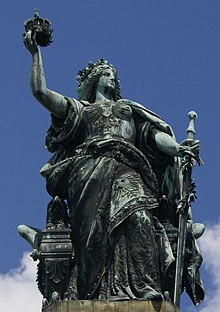Germania (personification)
show This article may be expanded with text translated from the corresponding article in German. (September 2021) Click [show] for important translation instructions. |


Germania is the personification of the German nation or the Germans as a whole, most commonly associated with the Romantic Era and the Revolutions of 1848, though the figure was later used by Imperial Germany.
Description[]
"Germania" is the Latin name of the country called "Deutschland" in the spoken language of its own inhabitants, though used as the country's name in various other languages, such as "Germany" in English. In the country itself, the use of the Latin "Germania" was mainly literary and poetical, linked with patriotic and nationalist feelings, like "Helvetia" for Switzerland, "Hibernia" for Ireland, "Caledonia" for Scotland, "Lusitania" for Portugal etc.
Germania as personification is usually depicted as a robust woman with long, flowing, reddish-blonde hair and wearing armour. She often wields the Reichsschwert (imperial sword), and possesses a medieval-style shield that sometimes bears the image of a black eagle on a gold field. Additionally, she is sometimes shown as carrying or wearing the Imperial Crown of the Holy Roman Empire.
In post-1918 images, the banner she holds is the black-red-gold flag of modern Germany, but in depictions from 1871 to 1918 it is the black-white-red flag of the German Empire.
Meanings of some symbols[]
| symbol | Significance |
|---|---|
| Broken chains | Being freed |
| Breastplate with eagle | Symbol of the German empire - strength |
| Crown of oak leaves | Heroism |
| Sword | Symbol of power, readiness to fight |
| Olive branches around the sword | Willingness to make peace |
| Black, red and gold tricolour | Flag of the liberal-nationalists in 1848; banned by princes of the German states |
| Rays of the rising sun | Beginning of a new era |
In media[]
In 2019 Ruby Commey portrayed Germania in the music video for Rammstein's song Deutschland, which was a number-one single in several countries, but also attracted significant controversy due to her being an Afro-German.[1][2]
See also[]
- Flag and Coat of Arms of Germany
- Bavaria statue, personification of the Land of Bavaria
- Berolina, personification of Berlin
- Deutscher Michel, personification of the German people
- Hammonia, personification of Hamburg
References[]
- ^ Stuart Braun (29 March 2019). "Rammstein video furore: Far-right clickbait or anti-fascist art?". Deutsche Welle. Retrieved 19 September 2019.
- ^ "Schwarze Frau als Germania - Kritik an Rammstein-Video". 29 March 2019. Retrieved 19 September 2019.
- Lionel Gossman. "Making of a Romantic Icon: The Religious Context of Friedrich Overbeck's 'Italia und Germania'." American Philosophical Society, 2007. ISBN 0-87169-975-3.
External links[]
| Wikimedia Commons has media related to Germania (personification). |
- Germania Briefmarken (in German)
- National personifications
- National symbols of Germany